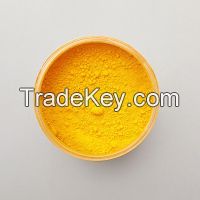Description
Tartrazine, also known as Yellow No. 5, is a synthetic yellow azo
dye used widely in the food and beverage industry. Heres a
comprehensive overview of its properties, uses, and safety
considerations:
### **Properties:**
- **Appearance**: Yellow crystalline powder or granular solid.
- **Chemical Formula**: C₁₀H₁₂N₄Na₃O₁₀S₂.
- **Solubility**: Soluble in water, forming a bright yellow
solution.
- **Molecular Weight**: **4.*6 g/mol.
### **Uses:**
1. **Food Coloring**:
- **Food and Beverages**: Tartrazine is used to impart
a yellow color to a variety of food products, including
confectionery, snacks, beverages, and sauces.
- **Desserts**: It is commonly found in candies, ice
creams, and baked goods.
2. **Cosmetics and Personal Care**:
- **Colorant**: It is used as a colorant in some
cosmetics and personal care products.
3. **Pharmaceuticals**:
- **Tablet Coatings**: Tartrazine is used in the
coloring of certain pharmaceuticals and over-the-counter
medications to improve appearance.
4. **Other Applications**:
- **Textiles**: It is sometimes used in the dyeing of
textiles and in other industrial applications requiring yellow
coloring.
### **Safety and Handling:**
- **Allergies and Sensitivities**:
- **Allergic Reactions**: Tartrazine can cause allergic
reactions in some individuals, particularly those with asthma or
aspirin sensitivity. Reactions may include hives, itching, or
asthma exacerbation.
- **Regulations**: Due to potential allergic reactions, many
countries have regulations requiring that foods containing
tartrazine be labeled accordingly.
- **Toxicity**:
- **General Safety**: Tartrazine is considered safe for
consumption within regulated limits set by food safety authorities.
However, excessive consumption should be avoided.
- **Handling**:
- **Protective Equipment**: Use appropriate personal
protective equipment (PPE) such as gloves and masks to avoid
inhalation or direct contact with the powder.
- **Ventilation**: Handle tartrazine in well-ventilated
areas to minimize inhalation of dust.
- **Storage**:
- **Conditions**: Store tartrazine in a cool, dry place,
away from moisture and light. It should be kept in a tightly sealed
container to prevent contamination and degradation.
- **Disposal**:
- **Waste Management**: Dispose of tartrazine according to
local regulations. It is typically considered non-hazardous waste,
but disposal should follow safety guidelines to avoid environmental
contamination.
### **Regulations:**
- **Food and Drug Administration (FDA)**: Tartrazine is approved
for use in foods and beverages by the FDA and other regulatory
bodies, but its use is subject to specific limits. It must be
listed on product labels to inform consumers.
- **European Food Safety Authority (EFSA)**: In Europe, tartrazine
is regulated by EFSA, which sets limits on its use and requires
clear labeling on food products.
### **Environmental Impact:**
- **Biodegradability**: Tartrazine is generally not considered
highly persistent in the environment. However, care should be taken
in its disposal to minimize any potential environmental impact.
If you have more specific questions about tartrazine, such as its
use in a particular product or detailed safety information, feel
free to ask!
